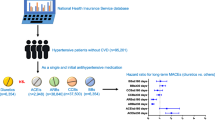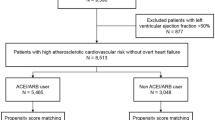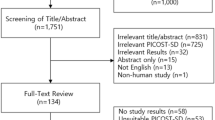Abstract
We aimed to analyze benefits and risks of aliskiren treatment in older adults (⩾65 years) in clinical practice. Patients (n=14 986) were assigned to either aliskiren (ALIS), an angiotensin-converting-enzyme inhibitor or angiotensin receptor blocker (ACEi/ARB), or an agent not blocking the renin–angiotensin system (non-RAS). Older adults (n=7396) had a longer history of hypertension (8.7 vs 4.7 years; P<0.0001), lower mean diastolic blood pressure (DBP; 87.7±11.0 vs 92.1±11.0 mm Hg) and more renal (12.0 vs 5.6%; P<0.0001) or cardiovascular disease (44.0 vs 18.9%; P<0.0001); 4548 received aliskiren (68.8%), 1215 ACEi/ARBs (18.4%) and 850 non-RAS treatments (12.9%). Office BP at 1 year was reduced by 18.4±21.5/7.2±12.0 mm Hg. BP reductions were greater (19.5±21.7/7.6±12.1 mm Hg) in the aliskiren group than in the ACEi/ARB (15.6±20.9/6.4±11.9) and non-RAS groups (16.1±20.7/6.5±11.7 mm Hg), respectively (P<0.0001 for systolic BP (SBP) and <0.01 for DBP). After multivariable adjustment, differences in SBP reductions were clinically irrelevant and no differences were noted for DBP. Adverse effects were higher in older adults with no differences between treatment groups. In conclusion, the present analysis of a large, unselected cohort of patients in clinical practice from the 3A study, offers real-life evidence of the effectiveness and safety of aliskiren for the treatment of hypertension in older adults.
This is a preview of subscription content, access via your institution
Access options
Subscribe to this journal
Receive 12 digital issues and online access to articles
$119.00 per year
only $9.92 per issue
Buy this article
- Purchase on Springer Link
- Instant access to full article PDF
Prices may be subject to local taxes which are calculated during checkout



Similar content being viewed by others
References
James PA, Oparil S, Carter BL, Cushman WC, Dennison-Himmelfarb C, Handler J et al. 2014 evidence-based guideline for the management of high blood pressure in adults: report from the panel members appointed to the Eighth Joint National Committee (JNC 8). JAMA 2014; 311: 507–520.
Mancia G, Fagard R, Narkiewicz K, Redon J, Zanchetti A, Bohm M et al. 2013 ESH/ESC Guidelines for the management of arterial hypertension: the Task Force for the management of arterial hypertension of the European Society of Hypertension (ESH) and of the European Society of Cardiology (ESC). J Hypertens 2013; 31: 1281–1357.
Gueyffier F, Bulpitt C, Boissel JP, Schron E, Ekbom T, Fagard R et al. Antihypertensive drugs in very old people: a subgroup meta-analysis of randomised controlled trials. INDANA Group. Lancet 1999; 353: 793–796.
Lewington S, Clarke R, Qizilbash N, Peto R, Collins R . Age-specific relevance of usual blood pressure to vascular mortality: a meta-analysis of individual data for one million adults in 61 prospective studies. Lancet 2002; 360: 1903–1913.
Turnbull F, Neal B, Ninomiya T, Algert C, Arima H, Barzi F et al. Effects of different regimens to lower blood pressure on major cardiovascular events in older and younger adults: meta-analysis of randomised trials. BMJ 2008; 336: 1121–1123.
Zanchetti A, Grassi G, Mancia G . When should antihypertensive drug treatment be initiated and to what levels should systolic blood pressure be lowered? A critical reappraisal. J Hypertens 2009; 27: 923–934.
Beckett NS, Peters R, Fletcher AE, Staessen JA, Liu L, Dumitrascu D et al. Treatment of hypertension in patients 80 years of age or older. N Engl J Med 2008; 358: 1887–1898.
Group JS . Principal results of the Japanese trial to assess optimal systolic blood pressure in elderly hypertensive patients (JATOS). Hypertens Res 2008; 31: 2115–2127.
Ogihara T, Saruta T, Rakugi H, Matsuoka H, Shimamoto K, Shimada K et al. Target blood pressure for treatment of isolated systolic hypertension in the elderly: valsartan in elderly isolated systolic hypertension study. Hypertension 2010; 56: 196–202.
Zhang Y, Zhang X, Liu L, Zanchetti A, Group FS . Is a systolic blood pressure target <140 mm Hg indicated in all hypertensives? Subgroup analyses of findings from the randomized FEVER trial. Eur Heart J 2011; 32: 1500–1508.
Mukhtar O, Jackson SH . Risk: benefit of treating high blood pressure in older adults. Br J Clin Pharmacol 2013; 75: 36–44.
Gradman AH, Schmieder RE, Lins RL, Nussberger J, Chiang Y, Bedigian MP . Aliskiren, a novel orally effective renin inhibitor, provides dose-dependent antihypertensive efficacy and placebo-like tolerability in hypertensive patients. Circulation 2005; 111: 1012–1018.
Nussberger J, Gradman AH, Schmieder RE, Lins RL, Chiang Y, Prescott MF . Plasma renin and the antihypertensive effect of the orally active renin inhibitor aliskiren in clinical hypertension. Int J Clin Pract 2007; 61: 1461–1468.
O'Brien E, Barton J, Nussberger J, Mulcahy D, Jensen C, Dicker P et al. Aliskiren reduces blood pressure and suppresses plasma renin activity in combination with a thiazide diuretic, an angiotensin-converting enzyme inhibitor, or an angiotensin receptor blocker. Hypertension 2007; 49: 276–284.
Oh BH, Mitchell J, Herron JR, Chung J, Khan M, Keefe DL . Aliskiren, an oral renin inhibitor, provides dose-dependent efficacy and sustained 24-hour blood pressure control in patients with hypertension. J Am Coll Cardiol 2007; 49: 1157–1163.
Oparil S, Yarows SA, Patel S, Fang H, Zhang J, Satlin A . Efficacy and safety of combined use of aliskiren and valsartan in patients with hypertension: a randomised, double-blind trial. Lancet 2007; 370: 221–229.
Duprez DA, Munger MA, Botha J, Keefe DL, Charney AN . Aliskiren for geriatric lowering of systolic hypertension: a randomized controlled trial. J Hum Hypertens 2010; 24: 600–608.
Zeymer U, Dechend R, Deeg E, Kaiser E, Senges J, Pittrow D et al. Aliskiren for the treatment of essential hypertension under real-life practice conditions: design and baseline data of the prospective 3A registry. Int J Clin Pract 2012; 66: 251–261.
Verband der forschenden Arzneimittelhersteller (VfA). Registry of non-interventional studies (NIS): 3A Register [accessed 11.03.2014]; Available from: http://www.vfa.de/de/arzneimittel-forschung/datenbanken-zu-arzneimitteln/nisdb/nis-details/_616.
Messerli FH, Sundgaard-Riise K, Ventura HO, Dunn FG, Glade LB, Frohlich ED . Essential hypertension in the elderly: haemodynamics, intravascular volume, plasma renin activity, and circulating catecholamine levels. Lancet 1983; 2: 983–986.
Kario K, Eguchi K, Hoshide S, Hoshide Y, Umeda Y, Mitsuhashi T et al. U-curve relationship between orthostatic blood pressure change and silent cerebrovascular disease in elderly hypertensives: orthostatic hypertension as a new cardiovascular risk factor. J Am Coll Cardiol 2002; 40: 133–141.
Fleg JL, Tzankoff SP, Lakatta EG . Age-related augmentation of plasma catecholamines during dynamic exercise in healthy males. J Appl Physiol (1985) 1985; 59: 1033–1039.
Littlejohn TW 3rd, Trenkwalder P, Hollanders G, Zhao Y, Liao W . Long-term safety, tolerability and efficacy of combination therapy with aliskiren and amlodipine in patients with hypertension. Curr Med Res Opin 2009; 25: 951–959.
Acknowledgements
The study was funded by Novartis Pharma GmbH, Germany.
Author information
Authors and Affiliations
Corresponding author
Ethics declarations
Competing interests
FS, UZ, RD, IT, CZ, PB, DP, JS and RES have received speaker’s fees and consulting honoraria from Novartis and other manufacturers of antihypertensive drugs. IH is a full-time employee of Novartis Pharma GmbH, Germany. TR reports no conflict of interest.
Rights and permissions
About this article
Cite this article
Friedrich, S., Zeymer, U., Dechend, R. et al. The impact of age on the benefits and risks of aliskiren treatment: analyses of the 3A registry. J Hum Hypertens 29, 316–323 (2015). https://doi.org/10.1038/jhh.2014.86
Received:
Revised:
Accepted:
Published:
Issue Date:
DOI: https://doi.org/10.1038/jhh.2014.86



